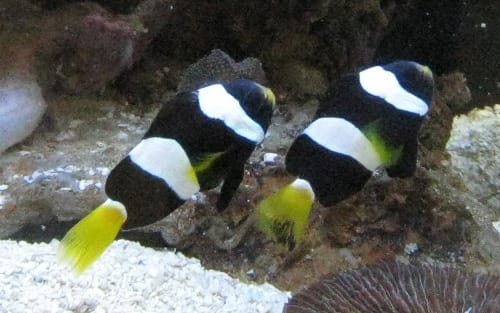Your aquarium must meet appropriate water conditions before you add any livestock! Always Test Your Water before adding new livestock. Selecting your first fish can be very exciting, but before you make a purchase be sure to do your homework. Saltwater fish can be broken down into two basic categories: Reef Safe and Fish Only. Reef Safe fish are generally compatible with one another and will not harm corals and invertebrates, although there are always exceptions to the rules. If you’ve keep freshwater, this would be a community tank. Fish Only fish tend to be larger and more aggressive and will typically eat corals and invertebrates. Some fish like Seahorses and Mandarin Gobies require special care and proper accommodations should be made before bringing one home. These two species are not good first fish.
The First Fish & How Many Fish
Unlike freshwater fish tanks, there is not a general rule of thumb to how many fish can be safely kept in an aquarium. Your aquarium is considered overstocked when fish become hostile towards one another, show signs of stress from lack of swimming room and your Filtration can no longer meet the demands. Hopefully your aquarium never reaches this point. As your bio-load increases, it puts strain on your filter and makes it more difficult to maintain water quality. This should be taken into consideration if you plan on keeping certain species of corals.
When & How to Stock a Saltwater Aquarium
Start by adding your first fish and then be patient until your aquarium cycles. Once your aquarium has 0 Ammonia and nitrites and less than 20 nitrates it is safe to add another fish. When stocking an aquarium, start by adding the smallest and least aggressive fish and finish with the largest and most aggressive. This will allow the smaller fish to become comfortable before a larger tank mate is added. If done in reverse, the more aggressive fish may become territorial and harass the smaller fish to death.

Continue to repeat this process, until your aquarium becomes full or you become satisfied. You may consider Quarantining new fish to prevent the risk of disease from entering your aquarium. Most experts will suggest quarantining new fish for up to six weeks. Although it is difficult to wait, it is important take your time as success comes with patience. If you do not plan on quarantining you may add a new fish every two to four weeks. This time will allow your aquarium stabilize and for new bacteria to grow.
When considering larger fish like Tangs and Surgeonfish, your aquarium should have proper swimming room. Also remember that corals will grow and will disrupt swimming space. Most Tangs will quickly outgrow a 55 gallon aquarium, so be prepared to trade it in as the fish grows in size. Most of these fish can grow to 12 inches or more and have spikes on each side of the tail. They will flare these spikes when scared or threatened, so caution should be taken when netting these fish.
Remember to take your time and be patient! Stocking your aquarium slowly will greatly increase your chances for success and compatibility. Remember to research every fish before you buy it, and try to avoid impulse purchases.
